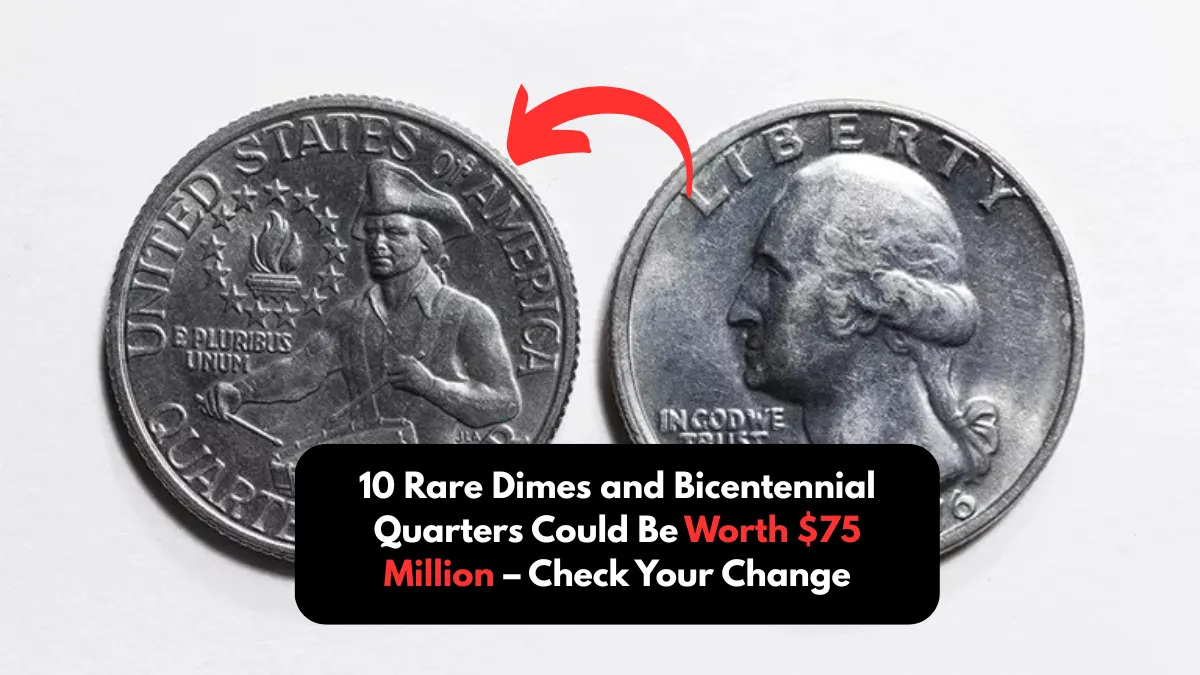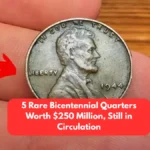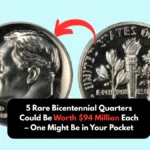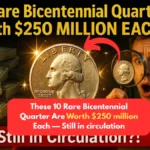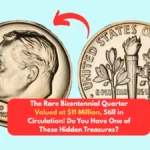Most people don’t give much thought to the coins in their pockets. But hiding among the nickels and pennies could be a dime or quarter worth thousands—or even millions. Rare minting errors, unique metals, and limited production runs have turned certain dimes and Bicentennial quarters into highly sought-after treasures.
It may sound unbelievable, but the estimated combined worth of some of these rare coins exceeds $75 million. What’s even more exciting is that a few of them are still in everyday use—sitting in coin jars, pockets, or cash drawers, just waiting to be found.
Take a closer look at 10 incredibly rare and valuable dimes and Bicentennial quarters that might already be in your possession.
1. 1975 No-S Roosevelt Dime
Estimated Value: Up to $500,000
Why It’s Rare: This coin lacks the mint mark that should identify it as coming from the San Francisco Mint
Key Traits: No “S” under the date, proof-like surface finish
Only a handful of these 1975 Roosevelt dimes were mistakenly struck without the “S” mint mark, and they were released as part of proof sets. With only two confirmed examples, this rare coin could fetch half a million dollars if discovered in pristine condition.
2. 1894-S Barber Dime
Estimated Value: $1.5 million–$2 million
Why It’s Rare: Just 24 coins were minted, and fewer than 10 remain known today
Key Traits: “S” mint mark located beneath the wreath on the back
The 1894-S Barber Dime is one of the rarest coins in U.S. history. While you’re not likely to find one in your spare change, one could be tucked away in an old family collection or forgotten estate sale, waiting for a lucky discovery.
3. 1982 No P Roosevelt Dime
Estimated Value: $35,000–$50,000
Why It’s Rare: Minted in Philadelphia but missing the “P” mint mark
Key Traits: Smooth surface near the date with no mint mark
This unusual coin was struck in 1982 during a time when Philadelphia began using a “P” mint mark. A small number of coins were accidentally released without it, creating a desirable error coin that often appears in circulated rolls.
4. 1976 Bicentennial Silver Proof Quarter
Estimated Value: $10,000+
Why It’s Rare: Only made in limited numbers for collector proof sets
Key Traits: Features an “S” mint mark and a silver, rather than copper-nickel, finish
Bicentennial quarters were issued to celebrate 200 years of American independence, and some were made with 40% silver content in special proof sets. A flawless proof version, particularly with unique traits, can be worth a significant amount.
5. 1976 Bicentennial Quarter Double Die Obverse
Estimated Value: $5,000–$25,000+
Why It’s Rare: Shows duplicated letters and date due to a die error
Key Traits: Look for doubling on “LIBERTY” and “IN GOD WE TRUST”
Double die coins attract major interest, and when the error appears on a commemorative coin like the Bicentennial quarter, collectors will pay top dollar. Sharp doubling of the design elements boosts the coin’s value significantly.
6. 1968 No-S Roosevelt Dime
Estimated Value: Up to $50,000
Why It’s Rare: Proof coin struck in San Francisco but released without an “S” mint mark
Key Traits: Lacks the “S” under the date, high-gloss finish typical of proof coins
This proof coin error slipped through without the expected mint mark, creating a scarcity that appeals to serious collectors. Only a few were made, and they command high prices when found in excellent condition.
7. 1976 Bicentennial Quarter Struck on Wrong Planchet
Estimated Value: $15,000–$85,000+
Why It’s Rare: Was struck using a blank intended for another coin or denomination
Key Traits: Unusual weight, color, or smaller-than-usual size
Sometimes the U.S. Mint accidentally uses the wrong metal blank—called a planchet—to strike a coin. In these cases, a Bicentennial quarter might be made on a dime planchet, creating a rare and high-value mistake that collectors prize.
8. 1942/1 Mercury Dime Overdate
Estimated Value: $10,000–$30,000+
Why It’s Rare: A die flaw caused the year “1942” to be stamped over “1941”
Key Traits: Numbers in the date appear layered or overlapped
This overdate error happened when the Mint reused a die and didn’t fully remove the previous year’s date. It’s a tiny flaw but highly noticeable under magnification—and worth thousands when found in collectible shape.
9. 1976 Bicentennial Quarter with Missing Clad Layer
Estimated Value: $2,000–$7,000
Why It’s Rare: One side of the coin lacks its outer metal coating
Key Traits: One face appears copper-colored while the other remains typical
During production, a thin copper-nickel layer is bonded to each side of a copper core. In rare cases, one layer is missing, resulting in a visibly two-toned coin. This error is especially valuable when found on a historical issue like the Bicentennial quarter.
10. 1996-W Roosevelt Dime
Estimated Value: $500–$1,000+
Why It’s Rare: Only released in a special mint set and not for circulation
Key Traits: Includes the “W” mint mark for the West Point Mint
The 1996-W Roosevelt dime marked the 50th anniversary of the design and was only available through collector’s sets. It wasn’t put into general circulation, making it a sleeper gem that could still be hiding in a forgotten coin pile.
How to Check for Rare Coins in Your Change
You don’t have to be a professional numismatist to begin hunting for valuable coins. Start by grabbing a magnifying glass and inspecting the date and mint mark on each coin. Weigh coins on a digital scale—errors involving the wrong planchet will often have incorrect weights.
Compare the coin to verified images from reputable numismatic sites. Look for things like unusual coloring, missing layers, or doubled text. If you think you’ve found something promising, it’s smart to consult a certified coin dealer or submit the coin to a professional grading service like NGC or PCGS.
Final Thoughts: You Could Be Holding a Fortune
Not all valuable coins are hidden in vaults or displayed in exhibits. Some are still circulating every day, completely unnoticed. From error-struck Roosevelt dimes to one-of-a-kind Bicentennial quarters, these rare pieces can appear in the most ordinary places. So whether it’s pocket change or an old coin jar, the next time you take a closer look, you might just uncover a fortune that others have overlooked.
